 W
WAncestral houses of the Philippines or Heritage Houses are homes owned and preserved by the same family for several generations as part of the Filipino family culture. It corresponds to long tradition by Filipino people of venerating Ancestors and Elders. Houses could be a simple house to a mansion. The most common ones are the "Bahay na Bato". Some houses of prominent families had become points of interest or museums in their community because of its cultural, architectural or historical significance. These houses that are deemed of significant importance to the Filipino culture are declared Heritage House by the National Historical Commission of the Philippines (NHCP), previously known as the National Historical Institute (NHI) of the Philippines. Preservation is of utmost importance as some ancestral houses have come into danger due to business people who buy old houses in the provinces, dismantle them then sell the parts as ancestral building materials for homeowners wishing to have the ancestral ambiance on their houses. These ancestral houses provide the current generation a look back of the country's colonial past through these old houses.
 W
WOn May 14, 2008, the two-storey Gala–Rodriguez house was declared by the National Historical Institute of the Philippines as one of the three heritage houses in Sariaya, because of its notable historical and cultural significance. The house was designed by Dr. Juan Nakpil in the early 1930s and was owned by one of the most distinguished couples in Quezon, Dr. Isidro Rodriguez and Doña Gregoria Gala. The house is located in Rizal Street along with other opulent houses owned by the illustrados of old Sariaya. The Gala–Rodriguez House is listed as one of the Ancestral Houses in the Philippines, under Region IV-A.
 W
WThe Angel Araneta Ledesma Ancestral House is one of the heritage houses in Silay City, Negros Occidental, Philippines belonging to Angel Araneta Ledesma and his wife Rizalina Javelona Lopez. Also known as Balay Verde or the Green House, it is strategically located along Plaridel Street, near the Silay City Hall, the San Diego Pro-cathedral, Police Department, and the Puericulture Center.
 W
WThe Archdiocesan Chancery is a heritage house in the City of San Fernando, Pampanga. It was the former residence of Luis Wenceslao Dison and Felisa Hizon that was purchased by the Roman Catholic Archdiocese of San Fernando. It is now being used as the Archdiocesan Chancery.
 W
WThe Augusto P. Hizon House is a heritage house in the City of San Fernando in the Pampanga province of the Philippines. The house is located along Consunji Street in the city.
 W
WThe Nakpil-Bautista House is one of the old houses found in the district of Quiapo, Manila. It was built in 1914 by Arcadio Arellano. The two-house originally sits on two lots, having a total area of 500 square meters. The National Historical Commission of the Philippines declared the house as a cultural property on August 25, 2011. Today, the house is a museum showcasing items of the Katipunan, paintings, among others.
 W
WThe Balay Negrense, also known as Victor Fernandez Gaston Ancestral House is a museum in Silay City, Negros Occidental in the Philippines, showcasing the lifestyle of a late 19th-century Negrense sugar baron. It is notable for being the first museum to be established in the province of Negros Occidental.
 W
WThe Baliwag Municipal Library and Museum which is currently housed at the Lumang Munisipyo is the town’s center for historical and cultural heritage.
 W
WThe Bernardino Jalandoni Museum, also known as the Bernardino Jalandoni House, located along Rizal Street, Silay City, in the province of Negros Occidental, Philippines, is the original residence of the late Don Bernardino and Doña Ysabel Jalandoni. The museum is also known as the "Pink House" because of its conspicuous pink paint that easily grabs attention.
 W
WThe Boix House, also known as Teotico-Crespo House or Casa Boix, is a Bahay na bato heritage house located in Quiapo, Manila, Philippines. Owned by the Philippine Province of the Society of Jesus, the restoration of the house is currently being advocated by the civic group Kapitbahayan sa Kalye Bautista. The house typifies the Flowers in Trellis architectural style that was common during the latter part of Spanish rule in the Philippines in the 1890s.
 W
WThe President Carlos P. Garcia Heritage House is the residence of former Philippine President Carlos P. Garcia in Tagbilaran City, Bohol. It was declared as a heritage house by the National Historical Commission of the Philippines in 2009.
 W
WCasa Bernedo, also known as the Bernedo Ancestral House, is a two-storey ancestral house in Dipolog, Zamboanga del Norte in the Philippines.
 W
WThe Casa Consulado, also known as Iturralde Mansion or Iturralde House, is a heritage house located in Quiapo, Manila, Philippines. The house typifies the architectural style of Bandehadong Bahay na Bato that was common during the 1920s in the Philippines.
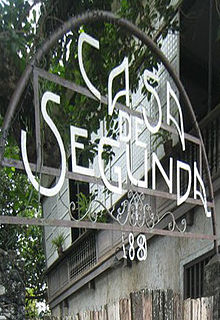 W
WThe Casa de Segunda, also known as Luz–Katigbak House, is a heritage house museum located along Rizal Street, Lipa City, Batangas. It was built during the 1860s and owned by Don Manuel Mitra de San Miguel-Luz and Doña Segunda Solis Katigbak, Dr. José Rizal's first love. The house was repaired in 1956 by Paz Luz-Dimayuga and was eventually declared a national heritage house by the National Historic Institute. At present, the house was converted into a museum.
 W
WCasa Manila is a museum in Intramuros depicting colonial lifestyle during Spanish colonization of the Philippines.
 W
WThe Casa Villavicencio or Casa V is an old Spanish Colonial Era house in Taal, Batangas, Philippines. Built in 1850, the house was given to Don Eulalio Villavicencio upon the death of his parents. In 1919, Governor General Francis B. Harrison slept in the house as a guest of Sen. Vicente Ilustre, son-in-law of Doña Gliceria, to inaugurate the electric plant in Taal.
 W
WThe Cesar Lacson Locsin Ancestral House is a heritage house known to be the home of El Ideal Bakery, the oldest bakery along Rizal and Eusebio Streets, National Highway, Silay, Negros Occidental, Philippines. The bakery is known for its "guapple" pie and several other local delicacies and sweets.
 W
WThe Clarin Ancestral House is the residence of the Clarin family, a prominent family of politicians from Loay, Bohol, Philippines. It is arguably the most visited of all ancestral houses in Bohol, along with the President Carlos P. Garcia Heritage House in Tagbilaran.
 W
WThe Consunji House is a heritage house in the City of San Fernando, Pampanga province in the Philippines.
 W
WDaku Balay is the ancestral home of Don Generoso Villanueva, situated on Burgos Street, Bacolod, Philippines.
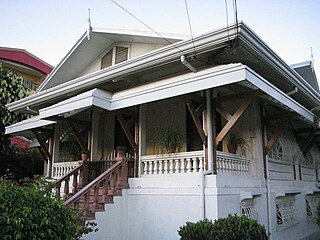 W
WThe Dayrit-Cuyugan House is a Bahay na Bato heritage house in the City of San Fernando, in the province of Pampanga, Philippines. This ancestral house, which exemplifies the architecture prevalent during the American colonial period was declared a Heritage House by the National Historical Institute on 27 January 2003 by virtue of Resolution No. 5, S. 2003.
 W
WDon Catalino Rodriguez Ancestral House, also known as Villa Sariaya, is one of the three houses declared by the National Historical Institute of the Philippines as Heritage house in Sariaya, Quezon. It was owned by Don Catalino Rodriguez, Sariaya’s town Presidente from 1908 to 1909. The house occupies an entire block near the church park. Its main entrance faces south along Calle Daliz and is bounded by Calle Rizal on the west and Quezon Avenue on the east. This house has already been transformed into a Museum and visitors can choose to wear period costumes for reasonable fees and pose for souvenir photos. Don Catalino Rodriguez Ancestral House is listed as one of the Ancestral Houses in the Philippines, under Region IV-A.
 W
WDr. Jose Corteza Locsin Ancestral House is a two-storey house built in the 1930s in Silay, Negros Occidental Philippines. It has been named as a Heritage Houses of the Philippines by the National Historical Commission of the Philippines.
 W
WThe Henson-Hizon House is a heritage house in the City of San Fernando, Pampanga, Philippines. This Bahay na Bato of the Spanish colonial period was declared a Heritage House by the National Historical Institute on 27 January 2003 by virtue of Resolution No. 3, S. 2003.
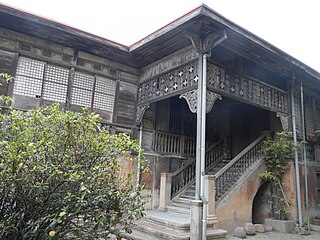 W
WThe Hizon-Ocampo House is a heritage house in the City of San Fernando, Pampanga.
 W
WThe Hizon-Singian House is a Bahay na Bato heritage house located in the City of San Fernando, Pampanga. Built in 1870 by the couple Don Anacleto Hizon, gobernadorcillo of San Fernando from 1877-1879 and 1886-1887, and Victoria Singian de Miranda y de Ocampo. Inherited by their daughter Victoria Hizon y Singian who was married to Godofredo Rodriguez y Yabut from Bacolor. It was occupied during the 1896 revolution by Spanish General Antonio Ruiz Serralde, appropriated by the Japanese Imperial Army to serve as a military hospital and barracks from 1943 to 1944, and served as headquarters of American General Walter Krueger of the 6th American Army during the liberation period until the end of 1945. Inherited by their son, the late Gerry Catalino Rodriguez Y Hizon, former president of the Pampanga Sugar Development Company (PASUDECO), who was married to Aurora Angeles. This bahay na bato of the Spanish colonial period was declared a Heritage House by the National Historical Institute on 27 January 2003 by virtue of Resolution No. 4, S. 2003.
 W
WThe Hofileña Ancestral House is the residence of the late Manuel Severino Hofileña and his family located in Cinco de Noviembre Street, Silay City, in the province of Negros Occidental, Philippines. The home was built by Hofileña for his wife Gilda Ledesma Hojilla, a former Miss Silay, and their nine children.
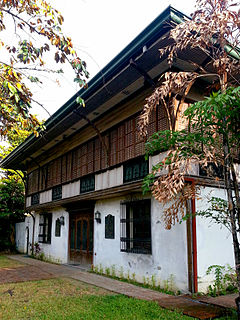 W
WThe Jose P. Laurel Ancestral House is a historic house in Manila, Philippines. It is one of the three houses owned by the President of the Second Philippine Republic, José P. Laurel. It is located in 1515 Peñafrancia Street in Paco District. President Laurel purchased the house in 1926 and served as his residence, together with his wife Paciencia Hidalgo and their children, for 29 years before he transferred to his retirement home in Mandaluyong.
 W
WThe Jusay Ancestral House is a historic house located in the Sampaloc neighborhood of Manila, in the Philippines. It was originally the home of the late couple Dr. Fernando Jusay and Rustica Palma which was eventually passed on to their late son Jose Jusay. The house was also called "The Door House" because it has so many doors inside. It was built in the early 1920s and its interiors as well as the exteriors are made of narra wood. Galvanized iron sheet was used as roofing and the wall found outside the house is made of cement. According to the wife of the late Jose Jusay, Melody Urbano-Jusay, the two-storey house used to have five rooms, two bathrooms, dirty kitchen and a kitchen at the second floor and a basement with a secret passage which is now covered with cement due to road elevations that took place throughout the years.
 W
WKapitan Moy Building, situated in Marikina, Metro Manila, the Philippines, is the 200-year-old house of Don Laureano Guevarra, known as the founder of the Marikina shoe industry. Also known as Kapitan Moy, he served as capitan municipal in the former municipality. A historical marker honoring him as the "Pioneer of the Shoe-making Industry in Marikina" was installed at his birthplace in 1970. Presently, there are two restaurants found in the ground floor of the Kapitan Moy Building and these are Café Kapitan Restaurant and Kusina ni Kambal. At the Café Kapitan Restaurant is an old well which serves as a décor and a wishing well to customers.
 W
WThe Lazatin House is one of the two heritage houses owned by the Lazatin family in the City of San Fernando, Pampanga province in the Philippines.
 W
WThe Legarda Ancestral House, or Legarda Mansion is the home of Dr. Alejandro Legarda and Doña Ramona Hernandez, a historic house located in San Miguel, Manila, Philippines. It was one of the first Art Deco houses in Metro Manila built in 1937. It was in 2001 that the house was converted into a restaurant called La Cocina de Tita Moning - an adaptive reuse for this heritage structure.
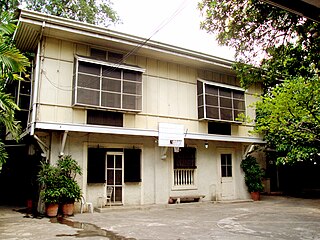 W
WThe Lichauco Heritage House, formally known as the O'Brien-Lichauco Heritage House is one of the oldest surviving houses in Santa Ana, Manila, Philippines. Originally built in 1859, the house was purchased in the late 1940s by a prominent Filipino lawyer and dignitary, Marcial Lichauco from a European family who had fled the Japanese occupation in the Philippines. The house was declared as a heritage house by the National Historical Commission on July 10, 2010. The Lichauco Heritage house is located along Pedro Gil Street. It is the only declared Heritage House in Santa Ana, and one of the only two declared heritage houses in Metro Manila along with Mira-Nila House in Quezon City.
 W
WThe Lopez Heritage House or Mansion de Lopez is a national heritage house built in 1928 located at Jaro, Iloilo by an Ilonggo statesman Don Vicente Lopez and his wife, Doña Elena Hofileña. The mansion was named after the couple's eldest daughter, Nelly Lopez y Hofileña. Due to its grandiose architecture highlighting the province's aristocratic past, it is regarded as the Queen of Heritage Houses in Iloilo. On March 28, 2004, it was declared as a National Historical Landmark by the National Historical Institute.
 W
WThe Malolos Historic Town Center is a historic district located in downtown or old town center of the capital town of Malolos City, Bulacan, Philippines commonly called Camestisuhan or Pariancillo District of Malolos with its collection of Spanish and American-era houses and government structures, as well as being the birthplace of the First Philippine Republic, the Malolos Constitution and being the capital of the Philippines from 1898–1900, the National Historical Institute declared the downtown Malolos city as a National Historical Landmark and a Heritage Town dated August 15, 2001.
 W
WThe Manila Hotel is a 570-room, historic five-star hotel located along Manila Bay in Manila, Philippines. The hotel is the oldest premiere hotel in the Philippines built in 1909 to rival Malacañang Palace, the official residence of the President of the Philippines and was opened on the commemoration of American Independence on July 4, 1912. The hotel complex was built on a reclaimed area of 35,000 square metres (380,000 sq ft) at the northwestern end of Rizal Park along Bonifacio Drive in Ermita. Its penthouse served as the residence of General Douglas MacArthur during his tenure as the Military Advisor of the Philippine Commonwealth from 1935 to 1941.
 W
WThe Mariano Ramos Ancestral House is the home of the late Mariano Ramos, first appointed Presidente Municipal of Bacolod, Philippines. It was built in the 1930s and its architecture is a combination of Castilian and Tuscan and comprises three storeys including the tower room, known as the torre and it is beside the Dizon-Ramos Museum.
 W
WThe Agoncillo–Mariño House is an old Spanish Colonial Era house in Taal, Batangas, Philippines. The house is one of the national shrines under the administration of the National Historical Commission of the Philippines (NHCP) with the purpose of memorializing the contribution of Marcela Mariño de Agoncillo in making the national flag of the Philippines and the deeds and ideals of Felipe Agoncillo y Encarnación, her husband, who came to be known as the "First Filipino Diplomat".
 W
WThe Mercado Mansion is a heritage house located in Carcar, Cebu, Philippines. It is a two-storey bahay-na-bato painted Mediterranean blue owned by the Mercado clan along Cebu South Road. It was declared a Heritage House by the National Historical Commission of the Philippines in 2009.
 W
WThe Pampanga Hotel is a heritage house in the City of San Fernando, Pampanga in the Philippines.
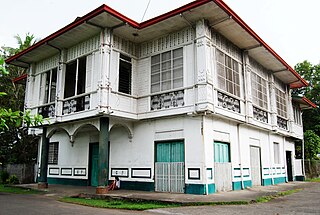 W
WLocated in the eastern portion of Misamis Oriental and roughly a 2-hour drive from Cagayan de Oro is the historical haven of North Poblacion in the Municipality of Medina where the Pelaez Ancestral House can be found standing still. This house had stood witness to the diverse political and historical lives of two of the famous bygone personalities in the politics arena in the locality and in the country as well – Don Gregorio A. Pelaez, Sr. and his son, Emmanuel N. Pelaez, Sr.. When people ask for direction, the local townsfolk refer to the house as the "Pelaez White House" because of the walls that are washed in white.
 W
WThe Pila Historic Town Center is a historic district located at Barangay Santa Clara Norte, Pila, Laguna, Philippines. The district preserves examples of Spanish and American-era architecture found in its town proper laid out with the Spanish colonial town planning system for the Indies and is also a pre-Hispanic archaeological site. The National Historical Institute declared a specific portion of Pila as a National Historical Landmark in 2000.
 W
WThe Quema House is the ancestral home of the Quema family in the Philippines. Built in the 1820s, it is a historic landmark in the town of Vigan, Ilocos Sur in the Philippines. The town itself was declared a UNESCO World Heritage Site in 1999.
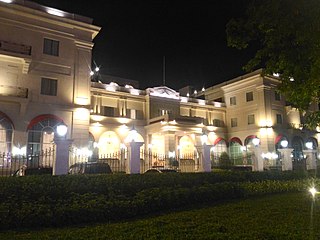 W
WThe Rizal Park Hotel is a 107-room, historic five-star hotel located along Manila Bay in Manila, Philippines. The hotel, which opened on 26 July 2017, occupies the Manila Army and Navy Club building following its redevelopment in 2014 by hotel developer Oceanville Hotel and Spa Corporation. Prior to the building's redevelopment, the building once served as the City Architect's Office and then as the Museo ng Maynila before being abandoned for several years.
 W
WThe Tabacalera House is a heritage house in the City of San Fernando, Pampanga in the Philippines.
 W
WThe Uitangcoy-Santos House is an early 20th-Century bay-na-bato structure along FT Reyes Street in Barangay Sto. Nino, in the city of Malolos, Bulacan, in the Republic of the Philippines. The home belonged to Paulino Santos—a Propetario and Cabeza de Barangay, and Alberta Uitangcoy-Santos—who was the leader of The Women of Malolos, and is revered for her contributions to Philippine women’s rights, the fight for Philippine independence, and a large part of Malolos' traditional cuisine during the Spanish and American colonial periods. The Uitangcoy-Santos House has been declared a national heritage house by the National Historical Commission of the Philippines, and is currently a privately owned museum that houses four exhibit halls and a lecture hall. The museum currently showcases collections of surviving artifacts and other memorabilia relevant to the narrative of the women and the Uitangcoy-Santos family.
 W
WThe Vega Ancestral House is one of the 1st Transition Bahay na Bato inspired houses that has been standing through times and witnessed the different colonial periods of the Philippines in its 200 (estimated) years of existence. Sculpted wooden Atlases are perhaps the most interesting feature of this house located in Poblacion, Balingasag, Misamis Oriental. Sculpted wooden atlases or, also known as, "Oti-ot" in Visayan language, provides support to the second floor protrusion of the house. This house is one important built structure in the locality that tourists usually come to visit. In fact, notable personalities like Emilio Aguinaldo and Sergio Osmeña had visited this house.
 W
WThe Villavicencio-Marella House or Wedding Gift House is an old Spanish Colonial Era house in Taal, Batangas, Philippines. The house was the wedding gift present of Don Eulalio Villavicencio to his wife Doña Gliceria Marella y Legaspi on the occasion of their wedding in 1871.